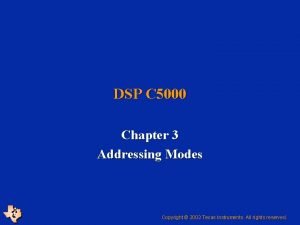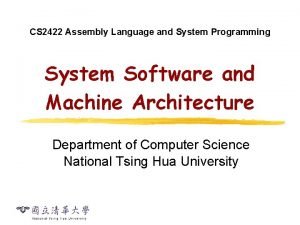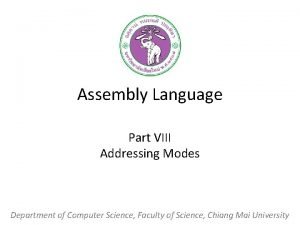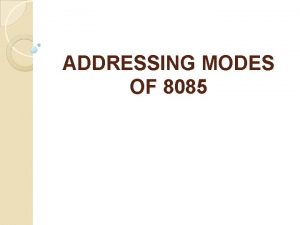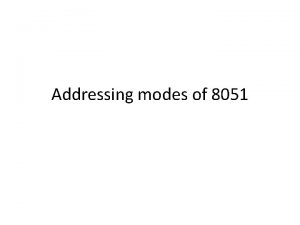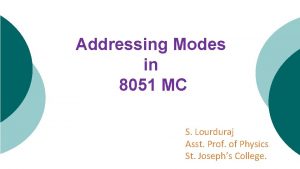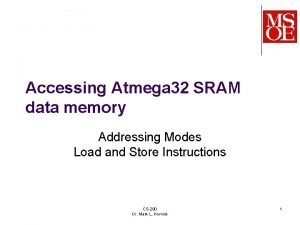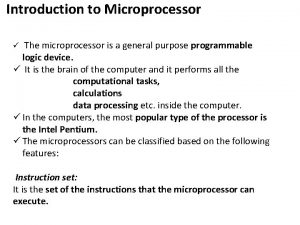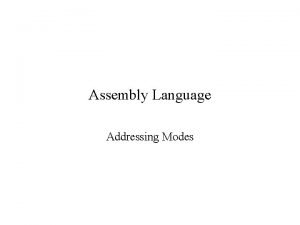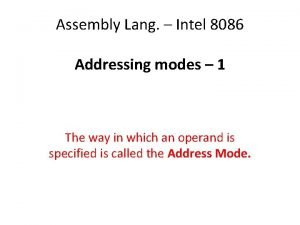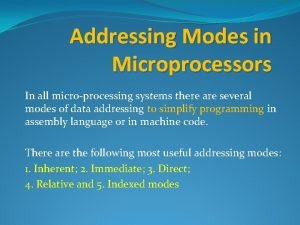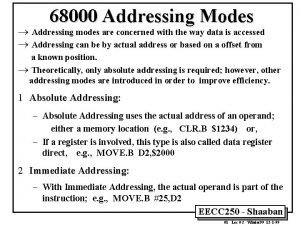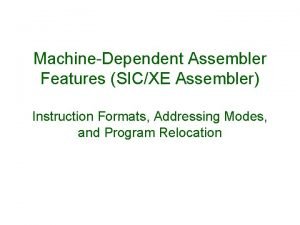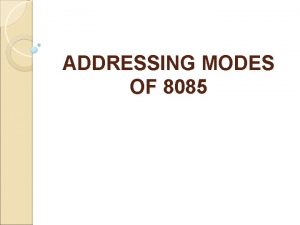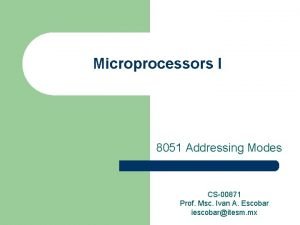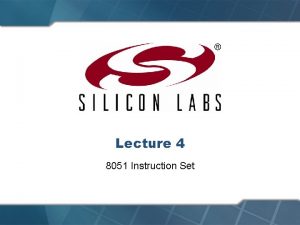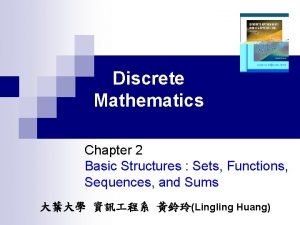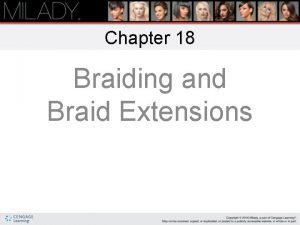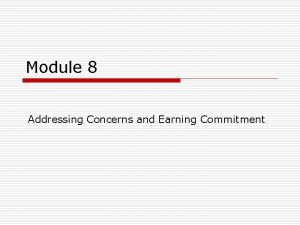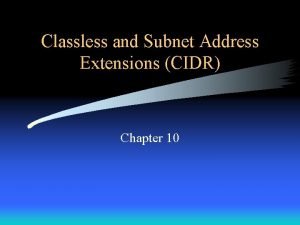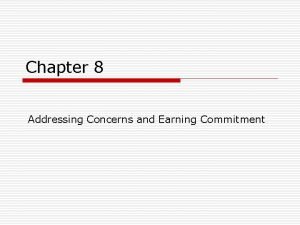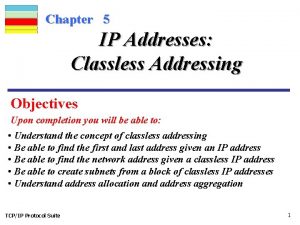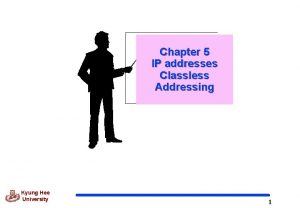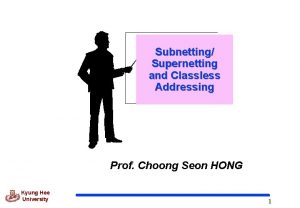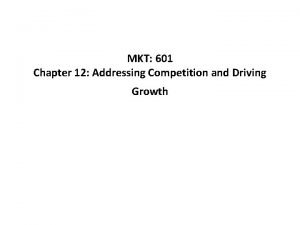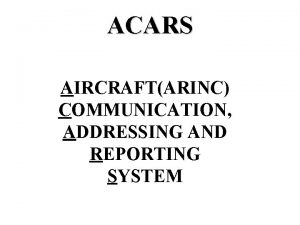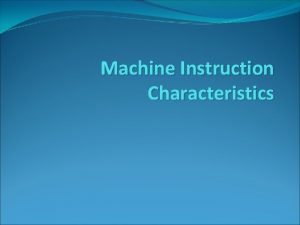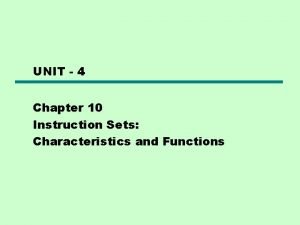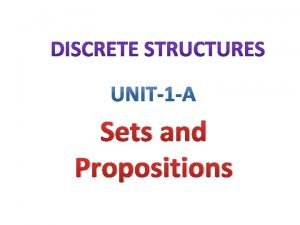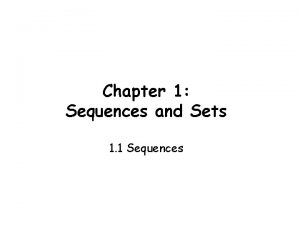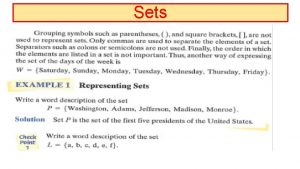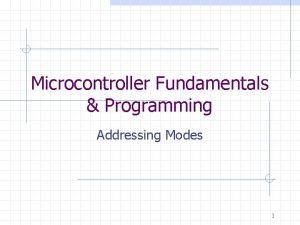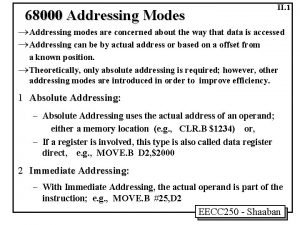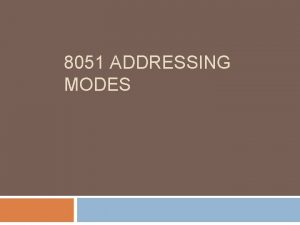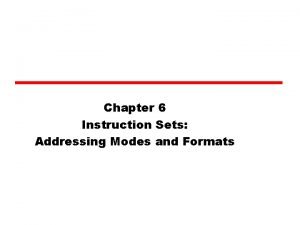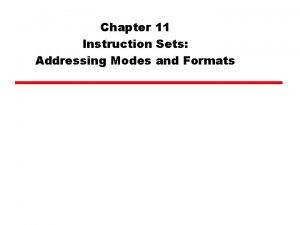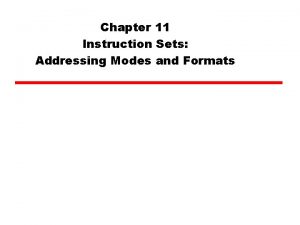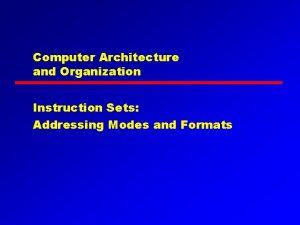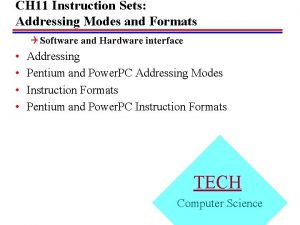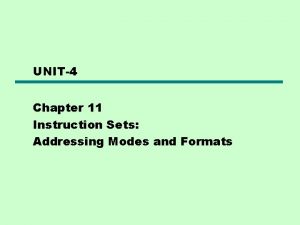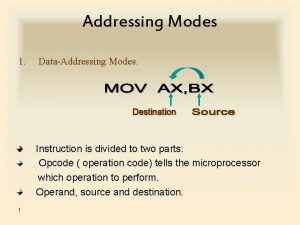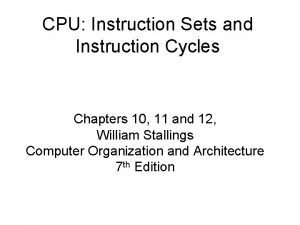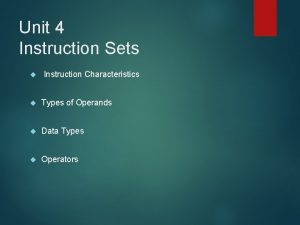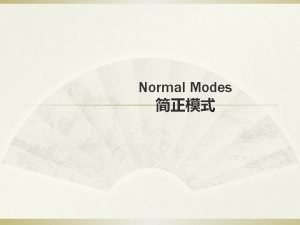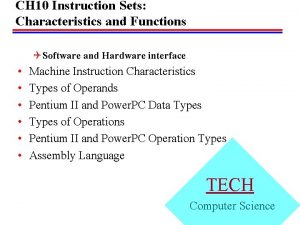Instruction Sets Characteristics and Functions Addressing Modes Chapters















































- Slides: 47

Instruction Sets: Characteristics and Functions Addressing Modes Chapters 10 and 11, William Stallings Computer Organization and Architecture 7 th Edition

What is an Instruction Set? • The complete collection of instructions that are understood by a CPU • Machine language: binary representation of operations and (addresses of) arguments • Assembly language: mnemonic representation for humans, e. g. , OP A, B, C (meaning A <- OP(B, C))

Elements of an Instruction • Operation code (opcode) – Do this: ADD, SUB, MPY, DIV, LOAD, STOR • Source operand reference – To this: (address of) argument of op, e. g. register, memory location • Result operand reference – Put the result here (as above) • Next instruction reference (often implicit) – When you have done that, do this: BR

Simple Instruction Format (using two addresses)

Instruction Cycle State Diagram

Design Decisions (1) • Operation repertoire – How many ops? – What can they do? – How complex are they? • Data types (length of words, integer representation) • Instruction formats – Length of op code field – Length and number of addresses (e. g. , implicit addressing)

Design Decisions (2) • Registers – Number of CPU registers available – Which operations can be performed on which registers? General purpose and specific registers • Addressing modes (see later) • RISC v CISC

Instruction Types • Data transfer: registers, main memory, stack or I/O • Data processing: arithmetic, logical • Control: systems control, transfer of control

Data Transfer • Store, load, exchange, move, clear, set, push, pop • Specifies: source and destination (memory, register, stack), amount of data • May be different instructions for different (size, location) movements, e. g. , IBM S/390: L (32 bit word, R<-M), LH (halfword, R<-M), LR (word, R<-R), plus floating-point registers LER, LE, LDR, LD Or one instruction and different addresses, e. g. VAX: MOV

Input/Output • May be specific instructions, e. g. INPUT, OUTPUT • May be done using data movement instructions (memory mapped I/O) • May be done by a separate controller (DMA): Start I/O, Test I/O

Arithmetic • Add, Subtract, Multiply, Divide for signed integer (+ floating point and packed decimal) – may involve data movement • May include – Absolute (|a|) – Increment (a++) – Decrement (a--) – Negate (-a)

Logical • Bitwise operations: AND, OR, NOT, XOR, TEST, CMP, SET • Shifting and rotating functions, e. g. – logical right shift for unpacking: send 8 -bit character from 16 -bit word – arithmetic right shift: division and truncation for odd numbers – arithmetic left shift: multiplication without overflow


Systems Control • Privileged instructions: accessing control registers or process table • CPU needs to be in specific state – Ring 0 on 80386+ – Kernel mode • For operating systems use

Transfer of Control • Skip, e. g. , increment and skip if zero: ISZ Reg 1, cf. jumping out from loop • Branch instructions: BRZ X (branch to X if result is zero), BRP X (positive), BRN X (negative), BRE X, R 1, R 2 (equal) • Procedure (economy and modularity): call and return

Branch Instruction

Nested Procedure Calls

Use of Stack: Saving the return address for reentrant procedures

Types of Operand • Addresses: immediate, direct, indirect, stack • Numbers: integer or fixed point (binary, twos complement), floating point (sign, significand, exponent), (packed) decimal (246 = 0000 0010 0100 0110) • Characters: ASCII (128 printable and control characters + bit for error detection) • Logical Data: bits or flags, e. g. , Boolean 0 and 1

Pentium Data Types • Addressing is by 8 bit unit • General data types: 8 bit Byte, 16 bit word, 32 bit double word, 64 bit quad word • Integer: signed binary using twos complement representation • (Un)packed decimal • Near pointer: offset in segment • Bit field • Strings • Floating point

Instruction Formats • • Layout of bits in an instruction Includes opcode Includes (implicit or explicit) operand(s) Usually more than one instruction format in an instruction set

Instruction Length • Affected by and affects: – Memory size – Memory organization - addressing – Bus structure, e. g. , width – CPU complexity – CPU speed • Trade off between powerful instruction repertoire and saving space

Allocation of Bits • Number of addressing modes: implicit or additional bits specifying it • Number of operands • Register (faster, limited size and number, 32) versus memory • Number of register sets, e. g. , data and address (shorter addresses) • Address range • Address granularity (e. g. , by byte)

Number of Addresses • More addresses – More complex (powerful? ) instructions – More registers - inter-register operations are quicker – Less instructions per program • Fewer addresses – Less complex (powerful? ) instructions – More instructions per program, e. g. data movement – Faster fetch/execution of instructions • Example: Y=(A-B): [(C+(Dx. E)]

3 addresses Operation Result, Operand 1, Operand 2 – Not common – Needs very long words to hold everything SUB Y, A, B Y <- A-B MPY T, D, E T <- Dx. E ADD T, T, C T <- T+C DIV Y, Y, T Y <- Y: T

2 addresses One address doubles as operand result – Reduces length of instruction – Requires some extra work: temporary storage MOVE Y, A Y <- A SUB Y, B Y <- Y-B MOVE T, D T <- D MPY T, E T <- Tx. E ADD T, C T <- T+C DIV Y, T Y <- Y: T

1 address Implicit second address, usually a register (accumulator, AC) LOAD D AC <- D MPY E AC <- ACx. E ADD C AC <- AC+C STOR Y Y <- AC LOAD A AC <- A SUB B AC <- AC-B DIV Y AC <- AC: Y STOR Y Y <- AC

0 (zero) addresses All addresses implicit, e. g. ADD – Uses a stack, e. g. pop a, pop b, add –c=a+b

Addressing Modes • • Immediate Direct Indirect Register Indirect Displacement (Indexed) Stack

Immediate Addressing • Operand is part of instruction • Operand = address field • e. g. , ADD #5 – Add 5 to contents of accumulator – 5 is operand • No memory reference to fetch data • Fast • Limited range

Direct Addressing • Address field contains address of operand • Effective address (EA) = address field (A) • e. g. , ADD A – Add contents of cell A to accumulator – Look in memory at address A for operand • Single memory reference to access data • No additional calculations needed to work out effective address • Limited address space (length of address field)

Direct Addressing Diagram Instruction Opcode Address A Memory Operand

Indirect Addressing (1) • Memory cell pointed to by address field contains the address of the operand • EA = (A) – Look in A, find effective address and look there for operand • E. g. ADD (A) – Add content of cell pointed to by content of A to accumulator

Indirect Addressing (2) • Large address space • 2 n where n = word length • May be nested, multilevel, cascaded – e. g. EA = (((A))) • Multiple memory accesses to find operand • Hence slower

Indirect Addressing Diagram Instruction Opcode Address A Memory Pointer to operand Operand

Register Addressing (1) • Operand is held in register named in address field • EA = R • Limited number of registers • Very small address field needed – Shorter instructions – Faster fetch

Register Addressing (2) • • No memory access Very fast execution Very limited address space Multiple registers helps performance – Requires good assembly programming or compiler writing – see register renaming • cf. direct addressing

Register Addressing Diagram Instruction Opcode Register Address R Registers Operand

Register Indirect Addressing • Cf. indirect addressing • EA = (R) • Operand is in memory cell pointed to by contents of register R • Large address space (2 n) • One fewer memory access than indirect addressing

Register Indirect Addressing Diagram Instruction Opcode Register Address R Memory Registers Pointer to Operand

Displacement Addressing • EA = A + (R) • Address field holds two values – A = base value – R = register that holds displacement – or vice versa • See segmentation

Displacement Addressing Diagram Instruction Opcode Register R Address A Memory Registers Displacement + Operand

Relative Addressing • • A version of displacement addressing R = Program counter, PC EA = A + (PC) i. e. , get operand from A cells away from current location pointed to by PC • cf. locality of reference & cache usage

Indexed Addressing • • A = base R = displacement EA = A + R Good for iteration, e. g. , accessing arrays – EA = A + R – R++ • Sometimes automated: autoindexing (signalled by one bit in instruction)

Stack Addressing • Operand is (implicitly) on top of stack • e. g. – ADD Pop two items from stack and add and push result on top

Power. PC Addressing Modes • Load/store architecture (see next slide): – Displacement and indirect indexed – EA = base + displacement/index – with updating base by computed address • Branch address – Absolute – Relative (see loops): (PC) + I – Indirect: from register • Arithmetic – Operands in registers or part of instruction – For floating point: register only

Power. PC Memory Operand Addressing Modes
 Flat addressing vs hierarchical addressing
Flat addressing vs hierarchical addressing Addressing modes of 8086
Addressing modes of 8086 Addressing modes of 8086 microprocessor
Addressing modes of 8086 microprocessor Immediate addressing mode
Immediate addressing mode Special addressing modes in dsp
Special addressing modes in dsp Sic machine architecture
Sic machine architecture Mov a, 3000 h is legal illegal
Mov a, 3000 h is legal illegal Addressing modes 8085
Addressing modes 8085 8051 addressing modes
8051 addressing modes Addressing modes of 8051
Addressing modes of 8051 Data memory of atmega32
Data memory of atmega32 Addressing modes of sic
Addressing modes of sic Introduction to microprocessor
Introduction to microprocessor Cisc addressing modes
Cisc addressing modes Based addressing mode in 8086
Based addressing mode in 8086 Addressing modes in microprocessor
Addressing modes in microprocessor 68000 addressing modes
68000 addressing modes Sic/xe object code calculation examples
Sic/xe object code calculation examples Types of addressing modes in 8085
Types of addressing modes in 8085 The address register for storing the 8-bit addresses can be
The address register for storing the 8-bit addresses can be Addressing modes
Addressing modes Addressing mode of the following instruction. lxi sp, c200h
Addressing mode of the following instruction. lxi sp, c200h Types of instruction set architecture
Types of instruction set architecture Anl instruction in 8051
Anl instruction in 8051 Sequence discrete math
Sequence discrete math Differentiated instruction vs individualized instruction
Differentiated instruction vs individualized instruction Direct instruction strategies
Direct instruction strategies Fuzzy sets and fuzzy logic theory and applications
Fuzzy sets and fuzzy logic theory and applications What is the most effective way to prepare hair for braiding
What is the most effective way to prepare hair for braiding Addressing concerns and earning commitment
Addressing concerns and earning commitment What is classful addressing?
What is classful addressing? Difference between classful and classless addressing
Difference between classful and classless addressing A traditional method of earning commitment is the
A traditional method of earning commitment is the Classless and classful
Classless and classful Classless addressing example
Classless addressing example Addressing competition and driving growth
Addressing competition and driving growth Address cont example
Address cont example Addressing competition and driving growth
Addressing competition and driving growth Acars format
Acars format What are the elements of machine instruction
What are the elements of machine instruction Teacher dominated approach
Teacher dominated approach Instruction set characteristics
Instruction set characteristics How to evaluate function
How to evaluate function Evaluating functions and operations on functions
Evaluating functions and operations on functions Sets and propositions
Sets and propositions Chromosome sets (=n) in mitosis and meiosis
Chromosome sets (=n) in mitosis and meiosis Chromosome sets (=n) in mitosis and meiosis
Chromosome sets (=n) in mitosis and meiosis Arithmetic sequence sigma notation
Arithmetic sequence sigma notation




